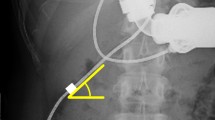Abstract
Although the survival rate for left ventricular assist device (LVAD) therapy has improved, device-related complications are an unpredictable threat to the patient’s quality of life. We focused on driveline infection, and aimed to determine whether specific features of drivelines affect the frequency of infection. We enrolled patients who underwent LVAD implantation and were followed-up at our institute between 2007 and 2015. We counted the occurrences of driveline infection requiring any antibiotic therapy over a 2-year study period. Furthermore, we experimentally measured and compared the outer diameters and stiffness of three devices. Of all, 72 patients received an LVAD during the enrollment period. LVADs were HeartMate II (n = 32), EVAHEART (n = 22), and DuraHeart (n = 18). The outer diameters and stiffness were measured in five of each device. HeartMate II group had the highest driveline infection-free rate among all three devices during the study period (p = 0.042). The driveline of the HeartMate II LVAD had a significantly smaller outer diameter and lower stiffness than that of the other two devices (p < 0.05 for both). In conclusion, device-specific driveline features may affect the development of driveline infection during LVAD therapy.





Similar content being viewed by others
References
Kirklin JK, Naftel DC, Pagani FD, Kormos RL, Stevenson LW, Blume ED, et al. Seventh INTERMACS annual report: 15,000 patients and counting. J Heart Lung Transplant. 2015;34:1495–504.
Zierer A, Melby SJ, Voeller RK, Guthrie TJ, Ewald GA, Shelton K, et al. Late-onset driveline infections: the Achilles’ heel of prolonged left ventricular assist device support. Ann Thorac Surg. 2007;84:515–20.
Topkara VK, Kondareddy S, Malik F, Wang IW, Mann DL, Ewald GA, et al. Infectious complications in patients with left ventricular assist device: etiology and outcomes in the continuous-flow era. Ann Thorac Surg. 2010;90:1270–7.
Hugonnet S, Sax H, Eggimann P, Chevrolet JC, Pittet D. Nosocomial bloodstream infection and clinical sepsis. Emerg Infect Dis. 2004;10:76–81.
Angud M. Left ventricular assist device driveline infections: the achilles’ heel of destination therapy. AACN Adv Crit Care. 2015;26:300–5.
Raymond AL, Kfoury AG, Bishop CJ, Davis ES, Goebel KM, Stoker S, et al. Obesity and left ventricular assist device driveline exit site infection. ASAIO J. 2010;56:57–60.
Imamura T, Kinugawa K, Nitta D, Inaba T, Maki H, Hatano M, et al. Readmission due to driveline infection can be predicted by new score by using serum albumin and body mass index during long-term left ventricular assist device support. J Artif Organ. 2015;18:120–7.
Goldstein DJ, Naftel D, Holman W, Bellumkonda L, Pamboukian SV, Pagani FD, et al. Continuous-flow devices and percutaneous site infections: clinical outcomes. J Heart Lung Transplant. 2012;31:1151–7.
Trachtenberg BH, Cordero-Reyes A, Elias B, Loebe M. A review of infections in patients with left ventricular assist devices: prevention, diagnosis and management. Methodist Debakey Cardiovasc J. 2015;11:28–32.
John R, Aaronson KD, Pae WE, Acker MA, Hathaway DR, Najarian KB, et al. Drive-line infections and sepsis in patients receiving the HVAD system as a left ventricular assist device. J Heart Lung Transplant. 2014;33:1066–73.
Asaki SY, Dean McKenzie E, Elias B, Adachi I. Rectus-sparing technique for driveline insertion of ventricular assist device. Ann Thorac Surg. 2015;100:1920–2.
Yarboro LT, Bergin JD, Kennedy JL, Ballew CC, Benton EM, Ailawadi G, et al. Technique for minimizing and treating driveline infections. Ann Cardiothorac Surg. 2014;3:557–62.
Leuck AM. Left ventricular assist device driveline infections: recent advances and future goals. J Thorac Dis. 2015;7:2151–7.
Menon AK, Baranski SK, Unterkofler J, Autschbach R, Moza AK, Goetzenich A, et al. Special treatment and wound care of the driveline exit site after left ventricular assist device implantation. Thorac Cardiovasc Surg. 2015;63:670–4.
Imamura T, Kinugawa K, Fujino T, Inaba T, Maki H, Hatano M, et al. Aortic insufficiency in patients with sustained left ventricular systolic dysfunction after axial flow assist device implantation. Circ J. 2015;79:104–11.
Imamura T, Kinugawa K, Nitta D, Hatano M, Kinoshita O, Nawata K, et al. Advantage of pulsatility in left ventricular reverse remodeling and aortic insufficiency prevention during left ventricular assist device treatment. Circ J. 2015;79:1994–9.
Hannan MM, Husain S, Mattner F, Danziger-Isakov L, Drew RJ, Corey GR, et al. Working formulation for the standardization of definitions of infections in patients using ventricular assist devices. J Heart Lung Transplant. 2011;30:375–84.
Toda K, Sawa Y. Clinical management for complications related to implantable LVAD use. Gen Thorac Cardiovasc Surg. 2015;63:1–7.
Felix F, Murat A, Doris M, Martin S, Axel H, Jan DS. Reduction of driveline infections through doubled driveline tunneling of left ventricular assist devices. Artif Organ. 2013;37:102–7.
Saito S, Yamazaki K, Nishinaka T, Ichihara Y, Ono M, Kyo S, et al. Post-approval study of a highly pulsed, low-shear-rate, continuous-flow, left ventricular assist device, EVAHEART: a Japanese multicenter study using J-MACS. J Heart Lung Transplant. 2014;33:599–608.
Haglund NA, Davis ME, Tricarico NM, Keebler ME, Maltais S. Readmissions after continuous flow left ventricular assist device implantation: differences observed between two contemporary device types. ASAIO J. 2015;61:410–6.
Dean D, Kallel F, Ewald GA, Tatooles A, Sheridan BC, Brewer RJ, et al. Reduction in driveline infection rates; results from the HeartMate II multicenter driveline Silicon Skin Interface (SSI) registry. J Heat Lung Transplant. 2015;34:781–9.
Acknowledgments
We express great appreciation for the offer of driveline samples from Thoratec and SUNMEDICAL Corporation and Terumo Heart, Inc.
Author information
Authors and Affiliations
Corresponding author
Ethics declarations
Conflict of interest
None.
Rights and permissions
About this article
Cite this article
Imamura, T., Murasawa, T., Kawasaki, H. et al. Correlation between driveline features and driveline infection in left ventricular assist device selection. J Artif Organs 20, 34–41 (2017). https://doi.org/10.1007/s10047-016-0923-8
Received:
Accepted:
Published:
Issue Date:
DOI: https://doi.org/10.1007/s10047-016-0923-8




